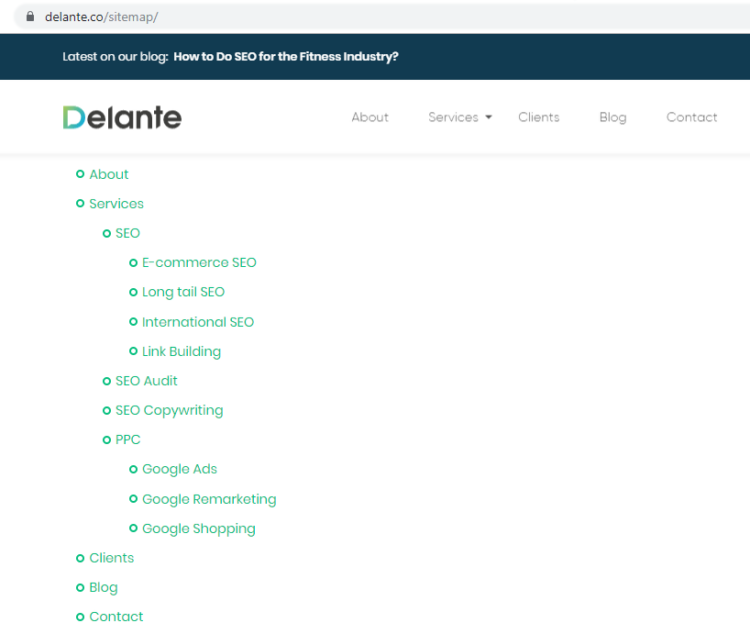Sitemap for SEO – Why Should You Care?

A sitemap is a list of the individual web pages in your site – it is a file embedded in your website to help the search engines index each of your web pages, and understand what your website is all about. Also, your website visitors can use your sitemap page to navigate on your site easily by just clicking-through your pages.
So, your sitemap for SEO helps you provide information about your web pages and other files on your site, such as videos and images, especially how each content relates to the other.
Today, we’ll take a look at the following:
- The importance of sitemap in SEO
- How to create a sitemap for SEO (concise info)
- Things to include in an SEO sitemap
- Types of sitemap in SEO
Let’s get started.
Is a Sitemap Important for SEO?
You bet it is. You see, a sitemap for SEO is essential because it is the file on your website that will make everything easier for the search engines “spiders,” especially Google, to locate your web pages and rank each one of them accordingly.
A sitemap for SEO will deem extremely helpful if you have web pages that are created dynamically, especially if you are in the e-commerce industry. Also, it will help you alleviate the problem of not having a well-structured website, also known as internal linking.
How Do I Create a Sitemap for SEO?
If you use WordPress as your content management system (CMS), you can create a sitemap with the help of the Yoast SEO plugin.
What we like about this plugin is that it creates a dynamic sitemap which updates automatically. For instance, if you add a new web page – a product page, a web article, or a blog post, the page link will be added to your sitemap file immediately.
Also, there are many other plugins that you can use in your WordPress CMS like Google XML Sitemaps.
Are you not using WordPress? No worries, you can use an excellent third-party sitemap generator tool such as the XML-Sitemaps.com.
Once your sitemap is created, you can request Google, given that it is the leading search engine in the world, to index each of your web pages by submitting your sitemap for SEO to your Google Search Console account.
- Log in to your GSC account
- Go to “Index”
- Click “Sitemap” located in the sidebar
- Enter your sitemap’s page URL into the “Add a sitemap” field
- Click submit
If you don’t have a Google Search Console account yet, or if you don’t have time to create a sitemap and send it, you can consult the sitemap and SEO specialists.
What Should Be Included in a Sitemap?
When creating your sitemap for SEO using a specific plugin or sitemap generator tool, it will automatically include all the media, web pages, archives, posts, and tags on your site. However, these are only basic elements.
Here are the essential things that you need to include when building your sitemap:
- Important web pages that contain high-quality and ultra-relevant content.
- Include sub-sitemaps to make your sitemap file more organized and more accessible for the search engines to process.
- If possible, submit a different sitemap file for your video content on your website.
- Remember to include only the URLs that are accessible to Google – meaning, forget about the web pages that have been blocked by robots or those that are way beyond password-protected sections.
- Include the “last modification time” field to inform Google how fresh or old your page is.
How Many Types of Sitemaps are there in SEO?
Generally, there are two types of sitemaps:
1. HTML Sitemap
This type of sitemap in SEO is written in Hypertext Markup Language, and it contains information about the resources on your website and their locations to help your website visitors find what they’re looking for easily.
Plus, the excellent internal linking structure of an HTML sitemap helps your website ranks better in the Search Engines Results Pages (SERP).
2. XML Sitemap
This type of sitemap for SEO is written in Extensible Markup Language, which is a language that contains information about an item that is within an organized template – a format understandable by both human readers and search engine “crawlers.”
Also, XML sitemaps have two types – an index sitemap which determined the number of URL sitemaps your website have, and a URL sitemap which contains the final information of web page URLs.
Plus, an XML sitemap can also feature video sitemaps, image sitemaps, and web page sitemaps.
Final Thoughts
Getting a well-structured sitemap for SEO can mean a massive difference in the success of your website in terms of click-through rates, search traffic, and conversions, simply because a sitemap in SEO can directly affect your internal linking, indexing, and user experience.
We understand that sitemap and SEO can be two different website success factors that may intertwine. Still, they can be extremely challenging to handle, let alone master. If you want to get ahead of your competitors in the SERPs, make sure to the sitemaps for SEO experts.




